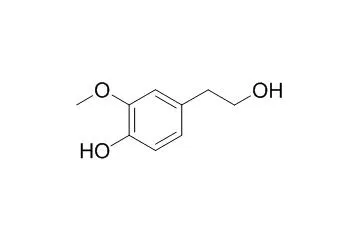| In vitro: |
| J Agric Food Chem. 2009 May 13;57(9):3478-82 | | Olive oil phenolic compounds inhibit homocysteine-induced endothelial cell adhesion regardless of their different antioxidant activity.[Pubmed: 19358606 ] | In this study, we examine the effect of extra virgin olive oil phenolic compounds on homocysteine-induced endothelial dysfunction and whether the protective effects are related to their different scavenging activities.
METHODS AND RESULTS:
Structurally related compounds have been assayed for their ability to reduce homocysteine-induced monocyte adhesion as well as the cell surface expression of intercellular adhesion molecule-1 (ICAM-1) in EA.hy.926 cells. As well-known, among the selected phenolic compounds, hydroxytyrosol, Homovanillyl alcohol, and the hydroxycinnamic acid derivatives caffeic and ferulic acid display high scavenging activities, while tyrosol and p-coumaric acid are poorly active. All of the tested compounds, approaching potential in vivo concentrations, significantly reduce homocysteine-induced cell adhesion and ICAM-1 expression.
CONCLUSIONS:
Interestingly, we report the first evidence that monophenols tyrosol and p-coumaric acid are selectively protective only in homocysteine-activated cells, while they are ineffective in reducing ICAM-1 expression induced by TNFalpha. Finally, we report the synergistic effect of o-diphenolic and monophenolic compounds. |
|
| In vivo: |
| Am J Clin Nutr. 2017 Jun;105(6):1297-1304. | | Protective effect of homovanillyl alcohol on cardiovascular disease and total mortality: virgin olive oil, wine, and catechol-methylathion.[Pubmed: 28446500 ] | Background: Hydroxytyrosol is a phenolic compound that is present in virgin olive oil (VOO) and wine. Hydroxytyrosol-related foods have been shown to protect against cardiovascular disease (CVD). We investigated the associations between hydroxytyrosol and its biological metabolite, 3-O-methyl-hydroxytyrosol, also known as Homovanillyl alcohol (HVAL), with CVD and total mortality.
METHODS AND RESULTS:
We included 1851 men and women with a mean ± SD age of 66.8 ± 6 y at high risk of CVD from prospective cohort data. The primary endpoint was a composite of myocardial infarction, stroke, and death from cardiovascular causes; the secondary endpoint was all-cause mortality. Twenty-four-hour urinary hydroxytyrosol and HVAL and catechol-O-methyltransferase (COMT) rs4680 genotypes were measured. After multivariable adjustment, all biomarkers were associated, as a continuous variable, with lower CVD risk, but only HVAL showed a strong inverse association (HR: 0.44; 95% CI: 0.25, 0.80) for the comparison between quintiles. Only HVAL, as a continuous variable, was associated with total mortality (HR: 0.81; 95% CI: 0.70, 0.95). Individuals in the highest quintile of HVAL compared with the lowest had 9.2 (95% CI: 3.5, 20.8) and 6.3 (95% CI: 2.3, 12.1) additional years of life or years free of CVD, respectively, after 65 y. Individuals with the rs4680GG genotype had the highest HVAL concentrations (P = 0.05). There was no association between COMT genotypes and events or interaction between COMT genotypes and HVAL concentrations.
CONCLUSIONS:
We report, for the first time to our knowledge, an independent association between high urinary HVAL concentrations and a lower risk of CVD and total mortality in elderly individuals. VOO and wine consumption and a high metabolic COMT capacity for methylation are key factors for high HVAL concentrations. The association that stems from our results reinforces the benefits of 2 key components of the Mediterranean diet (wine and VOO). |
|






 Cell. 2018 Jan 11;172(1-2):249-261.e12. doi: 10.1016/j.cell.2017.12.019.IF=36.216(2019)
Cell. 2018 Jan 11;172(1-2):249-261.e12. doi: 10.1016/j.cell.2017.12.019.IF=36.216(2019) Cell Metab. 2020 Mar 3;31(3):534-548.e5. doi: 10.1016/j.cmet.2020.01.002.IF=22.415(2019)
Cell Metab. 2020 Mar 3;31(3):534-548.e5. doi: 10.1016/j.cmet.2020.01.002.IF=22.415(2019) Mol Cell. 2017 Nov 16;68(4):673-685.e6. doi: 10.1016/j.molcel.2017.10.022.IF=14.548(2019)
Mol Cell. 2017 Nov 16;68(4):673-685.e6. doi: 10.1016/j.molcel.2017.10.022.IF=14.548(2019)